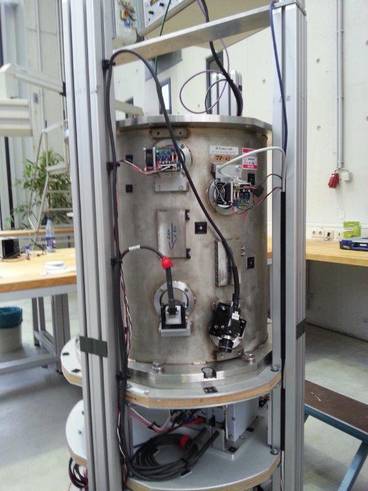Simulating the landing of a CubeSat on an asteroid (Land3U)

research area: technology tests
experiment title:
Simulating the Landing of a CubeSat on an Asteroid (Land3U)
experiment acronym: DYT
funding agency:
ESA (Education) / ZARM
grant number:
Drop Your Thesis! - Program
performing organization:
Astronautics and Space Engineering, Cranfield University, United Kingdom
prime investigator:
Prof. Joan Pau Sánchez / Prof. Luca Zanotti Fragonara
(Florian Gautier, Carole Le Blay, Elioenai Sitepu, Stuart Ogborne, Daniyal Ahmad Durrani, George Kersey)
experiment objective
abstract
An increasing number of interplanetary missions are aiming at visiting asteroids and other small bodies, since these may provide clues to understand the formation and evolution of our Solar System. CubeSats allow a low-cost solution to land on these objects, as opposed to risking a much more expensive mothership. The weak gravitational field on these small bodies may also enable the possibility of simply dropping a CubeSat from afar (i.e. ballistic landing). However, ballistic landing of an unpowered spacecraft would only be feasible within certain asteroid locations, and only if sufficient energy can be dissipated at touchdown. If such conditions are not met, the spacecraft will rebound off the surface and escape the asteroid. The amount of dissipated energy is measured by means of the coefficient of restitution, which is defined as the ratio between the velocities after and before the impact. It is likely that the necessary coefficient of restitution may already occur naturally due to the energy loss expected through the deformation of the regolith layer during the touchdown. Indeed, previous low-velocity impact experiments in microgravity seem to indicate that this is exactly the case. However, data from past asteroid touchdowns, Hayabusa and Philae, indicate the contrary. The paper describes an experiment developed by students from the Astronautics and Space Engineering MSc course at Cranfield University (Land3U Team), designed to bridge the aforementioned disagreement between mission data and microgravity experiments. The aim of this study is to understand the behavior of CubeSat landing on asteroids with an additional objective of developing a damping mechanism that could increase the dissipated energy. The experiment, will take place at the ZARM Drop Tower in Bremen next November 2018. With the opportunity of 5 drops at ZARM Drop Tower, the experiment will measure the coefficient of restitution during an available time window of 4.74 seconds of microgravity condition. A 1U CubeSat, mocking up a 3U mass, will be used to represent a future asteroid lander. In order to mimic the landing condition of actual missions, the mock-up will be given a velocity of 10-20cm/s with minimal tilting. This will be achieved by an automated release mechanism that will meet these requirements. An analogue of asteroid regolith will be selected to simulate its mechanical properties.
related publications
- Simulating the Landing of a CubeSat on an Asteroid (Land3U), Drop Your Thesis! 2018 - Final Report. ESA Human Spaceflight and Exploration, Erasmus Experiment Archive
experiment campaigns
experiment year: 2018
number of drops: 5


 "
"